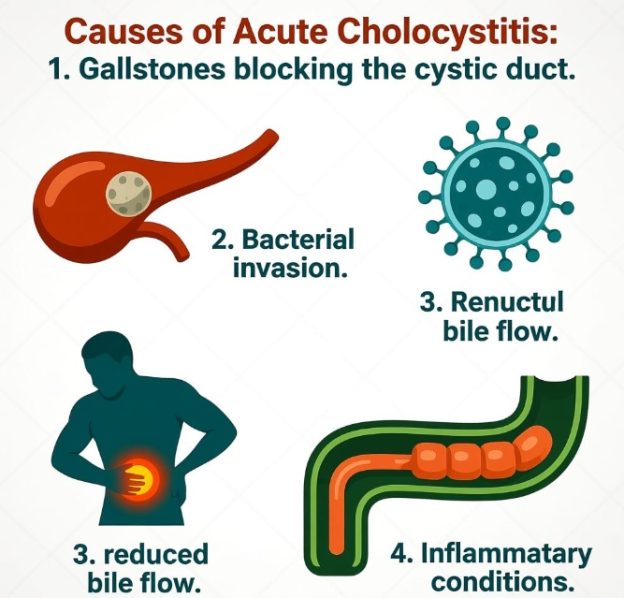Chronic cholecystitis denotes persistent, low-grade inflammation of the gall-bladder wall, usually in the setting of recurrent mechanical irritation by gallstones or, less commonly, chronic infection or metabolic deposition. Symptoms are episodic and less dramatic than those of acute cholecystitis, but they may culminate in fibrosis, loss of function, or acute exacerbation.
- Recurrent biliary colic
Episodic, post-prandial right-upper-quadrant or epigastric pain lasting 15–60 min, often precipitated by fatty foods and radiating to the inter-scapular region or right shoulder. Pain is typically self-limiting but becomes more frequent over time. - Dyspeptic syndrome
Early satiety, eructation, bloating, and nausea reflect impaired gall-bladder emptying and coexist with colicky episodes. - Fat intolerance
Patients report loose stools or diarrhoea following meals rich in fat, attributable to inadequate bile acid delivery to the duodenum. - Vague upper-abdominal discomfort
A dull, non-colicky heaviness or fullness persists between attacks, especially when the gall-bladder is distended by viscous bile or sludge. - Tender hepatomegaly
The liver edge remains smooth and mildly tender; the gall-bladder fundus may be palpable as a soft, non-distended mass that moves with respiration. - Laboratory changes
Serum alkaline phosphatase and γ-glutamyl transferase may be intermittently elevated; total bilirubin is usually normal unless common bile-duct stones coexist. Repeated episodes can raise C-reactive protein minimally. - Acute exacerbation
Sudden intensification of pain, high fever, or guarding signals progression to acute cholecystitis, gangrene, or empyema and mandates urgent evaluation.
| Symptom / Sign | Typical Presentation |
|---|---|
| Recurrent colic | Post-prandial RUQ pain 15–60 min, fatty trigger |
| Dyspepsia | Early satiety, bloating, eructation |
| Fat intolerance | Loose stools after rich meals |
| Vague discomfort | Dull heaviness between attacks |
| Tender organ | Soft, mildly tender gall-bladder edge |
| Laboratory | Intermittent ↑ ALP/GGT, normal bilirubin |
| Exacerbation | Sudden severe pain, fever, guarding |

